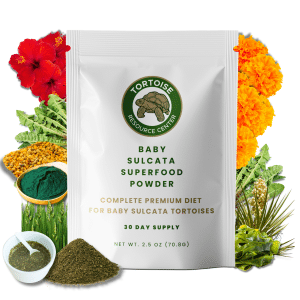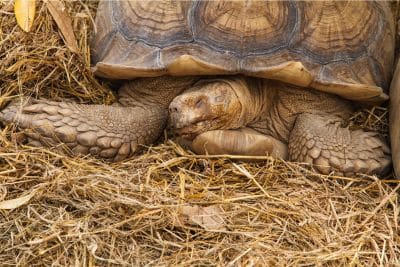Some tortoises live in tropical climates and are therefore capable of remaining active all year long. This includes rainforest-dwelling red-footed tortoises (Chelonoidis carbonaria) and desert-dwelling sulcatas (Centrochelys sulcata), among others.
But other tortoises live in areas with cold winter weather, which forces them to become inactive for several months per year. Accordingly, brumation (the reptilian equivalent of hibernation) is a regular part of life for these species in the wild.
And while it may not be strictly necessary in all cases, it is widely recommended that those keeping species that brumate in the wild to initiate a similar period in captivity.
There are a few different methods keepers use to do so, including the “box method,” which I’ll be focusing on in this article. Read on, and allow me to explain what the box method is and how to carry out the process.
What Is Box Method Hibernation?
There are a few different techniques keepers use to provide their tortoise with a suitable place to brumate. The box method is one of the oldest approaches, and many keepers continue to prefer it.
In a nutshell, the box method involves placing your tortoise in a box (technically, most keepers utilize a dual-box setup). The box is then placed in a cool area, which provides the proper temperature range.
Popular alternatives include the “refrigerator method,” which involves placing the tortoise in a specially calibrated refrigerator for the duration of hibernation and the “burrow method,” in which outdoor tortoises are allowed to construct their own burrows and spend the winter outdoors.
All of these approaches present different advantages and risks. The box method is generally safer than the burrow method but a bit riskier than the refrigerator method. With that said, it doesn’t require keepers to purchase and set up a second refrigerator (I don’t recommend you use your family’s refrigerator to brumate your pet!).
Box Method Step by Step Guide
Brumating your tortoise is not a quick endeavor. You’ll have to take a variety of steps to ensure your tortoise remains safe and healthy during the process:
1) Prepare the Box for Hibernation
Begin setting up your tortoise’s brumation box about one month before you plan to initiate the brumation period. To do so, you’ll want to:
- Select an internal box. This will be the box your tortoise is physically inside during the brumation period. Cardboard will work, but wooden boxes are better. It should be large enough for your tortoise to turn around but try not to provide much more room than this.
- Fill the box about ½ to 2/3 full with a suitable substrate. Some keepers like to use shredded newspaper, while others prefer soil or sand-soil mixtures. You should use enough substrate that your tortoise can be almost completely “dug in,” but not so much that he’ll have trouble breathing.
- Select an exterior box. This box will contain the other box and will help to provide more protection from drastic temperature swings. Most keepers prefer using a Styrofoam box, but wooden boxes or repurposed drink coolers will also work. In contrast to the internal box, there’s no compelling reason you have to select a small exterior box, aside from the space you have available to store it. In fact, the larger the exterior box is, the better, as it’ll better protect your tortoise from temperature extremes.
2) Pack to Insulate
Use insulating materials, such as packing peanuts or shredded newspaper to fill the inner box. Place a layer of insulating material in the base of the outer box and rest the inner box on top. Use more insulating material to fill the space between the inner and outer box on all sides.
3) Drill or cut two holes in the exterior box and one in the interior box.
Thread one thermometer probe through one of the holes in the external box and insert it inside the internal box. Thread the other thermometer probe through the external box but keep it outside the interior box. This way, you can monitor the temperature of both boxes. The temperatures will likely be similar, but it is better to be safe than sorry.
4) Find a Location for the Hibernation Box
You need a spot that is easily accessible but out of harm’s way. Most importantly, the right location will need to maintain the correct temperature for the duration of the hibernation period. Ideally, the temperature range will remain between about 37- and 45-degrees Fahrenheit (though it may vary slightly from one species to the next).
Garages, outbuildings, unheated basements, and exterior sheds are some of the places many keepers utilize. Note that you should begin this process before your tortoise is ready for brumation, so the temperatures may initially be a little higher than would be ideal.
Once you’ve found the location that provides proper temperatures, you can consider your brumation box ready for your tortoise.
Are You Starving Your Tortoise?
Save 10% on premium tortoise food and supplements from Tortoise Resource Center on Amazon now using code BUYNOWGET10

Sulcata Vitamin & Mineral Topper Supplement
30-Day Supply | 2 oz (56 g)
$24.99

Baby Sulcata Tortoise Superfood Powder
30-Day Supply | 2.5 oz (70.8 g) Bag
$24.99
5) Preparing Your Tortoise for Hibernation
You can’t simply set up the brumation box, toss your tortoise in, and expect things to go smoothly. Instead, you need to prepare your tortoise for the endeavor.
The primary thing you need to do is to empty your pet’s digestive tract. If food remains in his intestines during brumation, it may begin to decompose, which could sicken your pet.
Accordingly, you’ll want to begin withholding food for several weeks before initiating the brumation period. Two weeks may be sufficient for young tortoises, while larger, mature tortoises may need to fast for four weeks or longer to completely empty their digestive tract.
Many keepers also begin withholding water a week before brumation begins.
6) Brumating Your Tortoise
Once your tortoise has fasted long enough to empty his digestive tract, you can insert him in the hibernation box and begin the brumation period.
From this point forward, your responsibilities will essentially fall into two categories:
- Monitor the temperature of the brumation box regularly. For the first week or so of hibernation, you’ll want to check the temperatures at least once per day to ensure they’re within the correct range. If the temperatures are too cool, you may need to add a small heater to the room; if the temperatures are too high, you may need to find another location or add ice packs to the outside of the exterior box.
- Monitor your tortoise’s health once per week. You’ll want to check on your tortoise once per week to ensure he’s still healthy and that he hasn’t broken hibernation. He should appear to be asleep, yet conscious enough to withdraw his legs if they’re gently pinched. He shouldn’t exhibit any signs of illness, such as eye or nasal discharge.
If your tortoise appears to be waking up or active, you’ll need to break the brumation period and warm him back up. Never attempt to re-initiate a brumation period on a tortoise who’s become active.
7) Ending Your Tortoise’s Brumation
The length of brumation will vary based on your tortoise’s species, sex, and age. However, it will typically last for about 4 to 12 weeks (though some animals may be safely hibernated for 16 weeks or longer).
When it is time to end the brumation period, it is typically best to do so gradually. So, you may start by bringing the hibernation box indoors. A few days later, you can remove your tortoise from the box and place him back in his habitat. However, you may not want to restore his typical, 12- to 14-hour photoperiod. Instead, simply turn the lights and heating devices on for about 8 hours.
Maintain this approach for about one week and then restore full “summer” conditions.
You can begin offering water immediately upon placing your pet back in his enclosure, but most tortoises will not begin feeding for a few days.
Citations
- Tortoise Protection Group – The Box Method
- SwellReptiles – Tortoise Hibernation Guide
- Arizona Exotic Animal Hospital – Hibernation Recommendations for Tortoises and Turtles


